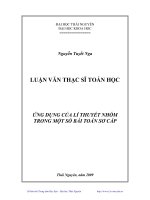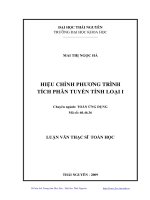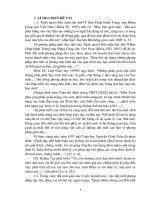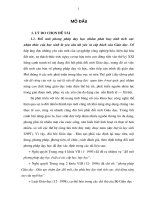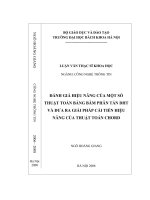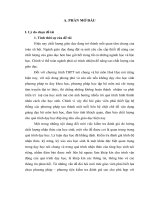(Luận văn thạc sĩ) screening and characterization of cellulase in bacillus sp
Bạn đang xem bản rút gọn của tài liệu. Xem và tải ngay bản đầy đủ của tài liệu tại đây (2.24 MB, 60 trang )
VIETNAM NATIONAL UNIVERSITY OF AGRICULTURE
SAMLEY MAM
SCREENING AND CHARACTERIZATION OF
CELLULASE IN BACILLUS sp.
Student:
Samley MAM
Student code:
24181065
Supervisor:
Dr. Nguyen Thi Thanh Thuy
Department:
Food safety and Quality management - VNUA
AGRICULTURAL UNIVERSITY PRESS - 2017
DECLARATION
This thesis contains no material that has been accepted for the award of any other
degree or diploma in any educational institution and, to the best of my knowledge and
belief, it contains no material previously published or written by other person, except
where due to reference is made in the text of the thesis.
Hanoi, May 10th, 2017
Master candidate
Samley MAM
i
ACKNOWLEDGEMENT
First of all, I would like to sincerely thank the Vietnam National University of
Agriculture (VNUA) in Vietnam, in particular the Faculty of Food Science and
Technology, for providing all the conditions leading to this thesis and allowing me to
follow the program Food Technology that financially supported by Académie de
Recherche et d’Enseignement Supérieur – Commission de la Cooperation au
Dévelopement (ARES-CCD).
I express my gratitude to my supervisor Dr. Nguyen Thi Thanh Thuy, for being
my mentor during my thesis research on “Screening and characterization of cellulase in
Bacillus sp.”. Especially, I would like to acknowledge her precious advices, the very
helpful discussions, and good explanation with her friendly encouragement.
I am very grateful to Ms. Trinh Thi Thu Thuy for being my co-supervisor an
offering me the great opportunity to perform my master work in her laboratory. On the
other hand, I really sincerely thank for her great support not only the idea but also her
value time to solve the problem that incidentally faced during this research.
I particularly thank her for sharing her well-guided expertise in the field of
characterization of cellulolytic enzyme, and for giving assistance supported.
I would like to offer a big thank to Dr. Nguyen Hoang Anh, head of Central
Laboratory, gave me a lot of advice and suggestion for my methodology.
Last but not least, I am deeply grateful to my beloved parents, namely, Mr. SVAY
KOU, Mrs. SOUT HUN, and my beloved siblings. This successful result could not be
obtained if without their encouragement and support.
Hanoi, May 10th, 2017
Master candidate
Samley MAM
ii
TABLE OF CONTENTS
DECLARATION ............................................................................................................... i
ACKNOWLEDGEMENT ................................................................................................ ii
TABLE OF CONTENTS................................................................................................. iii
LIST OF TABLES ............................................................................................................ v
LIST OF FIGURES ......................................................................................................... vi
THESIS ABSTRACT ..................................................................................................... vii
PART I – INTRODUCTION ............................................................................................ 1
1.1.
Introduction .............................................................................................. 1
1.2.
Objective .................................................................................................. 1
1.2.1.
General objective.............................................................................................. 1
1.2.2.
Specific objectives............................................................................................ 2
PART II –LITERATURE REVIEW ................................................................................ 3
2.1.
Cellulase ................................................................................................... 3
2.1.1.
General information of cellulase ...................................................................... 3
2.1.2.
Classification of cellulase................................................................................. 3
2.1.3.
Applications of cellulases in the industries ...................................................... 7
2.1.4.
Microbial sources of cellulases................................................................... 9
2.2.
Factors affect for cellulase production by Bacilli and characterization of
enzyme ................................................................................................... 13
2.2.1.
General information of Bacillus sp. and their cellulase production
ability.............................................................................................................. 13
2.2.2.
Factors affect the cellulase production ability of Bacillus sp......................... 16
2.2.3.
Characterization of cellulase produced by Bacillus sp................................... 18
PART III - MATERIALS AND METHODS ................................................................. 19
3.1.
Materials................................................................................................. 19
3.1.1.
Bacteria strain ................................................................................................. 19
3.1.2.
Medium .......................................................................................................... 19
3.2.
Research content ..................................................................................... 19
3.3.
Methods.................................................................................................. 20
iii
3.3.1.
Bacterial screening and characterization ........................................................ 20
3.3.2.
Experiment design .......................................................................................... 21
3.3.3.
Analytical method .......................................................................................... 22
3.3.4.
Data analysis .................................................................................................. 24
PART IV. RESULTS AND DISCUSSIONS ................................................................. 25
4.1.
Screening Bacillus sp. producing cellulase bacteria ................................... 25
4.2.
Identification of selected Bacillus sp. strains ............................................. 28
4.2.1.
Morphological characterization...................................................................... 28
4.2.2.
Sequencing of 16S rDNA gene ...................................................................... 28
4.2.3.
Cellulase production of Bacillus pumilus B6.4 .......................................... 30
4.3.
Characterization of cellulase activityof Bacillus pumilus B6.4 ................... 31
4.3.1.
Effect of optimal temperature for cellulase activity ....................................... 31
4.3.2.
Effect of optimal pH for cellulase activity ..................................................... 32
4.3.3.
Thermal stability on cellulase activity ........................................................... 33
4.3.4.
pH stability ..................................................................................................... 34
PART V. CONCLUSIONS ............................................................................................ 36
REFERENCES ............................................................................................................... 37
APPENDIX ..................................................................................................................... 47
iv
LIST OF TABLES
Table 2.1. Cellulase producing fungal strains................................................................. 10
Table 2.2. Cellulase producing by bacterial strains ........................................................ 12
Table 2.3. Optimum temperature and pH of enzyme produced by Bacillus sp. ............. 14
Table 4.1. Clear zone of cellulase produced by 100 strains of Bacillus sp. ................... 26
Table 4.2. Ratio of clear zone category .......................................................................... 27
Table 4.3.Thermal stability in enzyme activity (U/ml) .................................................. 33
Table 4.4. pH stability in enzyme activity (U/ml) .......................................................... 35
v
LIST OF FIGURES
Figure 2.1. Efficiency in cooperation of members of cellulase enzyme system .............. 4
Figure 3.1. Diagram for bacterial characterization ......................................................... 20
Figure 3.2. Screening cellulase production by the agar-well diffusion method ............. 20
Figure 4.1. Biggest clear zone of collection strains of A1.2, A1.8 and B 6.4 ................ 28
Figure 4.2. Cell morphology of strains A1.2, A1.8, and B6.4 ........................................ 28
Figure 4.3. Phylogenetic tree of Bacillus cereus A1.2 ................................................... 29
Figure 4.4. Phylogenetic tree Bacillus cereus A1.8 ........................................................ 29
Figure 4.5. Phylogenetic tree Bacillus pumilus B 6.4 ..................................................... 30
Figure 4.6. Effect of optimal temperature on enzyme production .................................. 31
Figure 4.7. Effect of optimal temperature on enzyme production .................................. 32
Figure 4.8. Thermal stability on enzyme production ...................................................... 34
Figure 4.9. pH stability on enzyme production .............................................................. 35
vi
THESIS ABSTRACT
Master candidate: Samley Mam
Thesis title: Screening and characterization of cellulase in Bacillus sp.
Major: Food Technology
Code:24181065
Educational Organization: Vietnam National University of Agriculture (VNUA)
General objectives: Screening and characterization of cellulase in Bacillus sp. and
determine some characteristic of this enzyme.
Specific objectives
- Screening Bacillus sp. producing cellulase from the collection of Bacillus sp.;
- Identification of selected strains by 16S rDNA gene sequencing;
- Characterization of cellulase produced by selected strain (including optimal
temperature, optimal pH, thermal stability and pH stability).
Materials and Methods
Materials
A hundred strains of Bacillus sp. were supplied by Faculty of Food Science and
Technology, Vietnam National University of Agriculture. There are two different
sources of collection strains, one from the Muong Khuong chili sauce and the other
from cow rumen.
Methods
Microorganisms with cellulolytic activity were incubated in MT1 media and
determined by the formation of clear zone around colony through the lugol overlay
method; Cellulolytic bacteria were identified by using 16S rDNA gene sequencing; the
neighbor - joining phylogenetic analysis was carried out with Tree view programme to
show evolution relationship between selected strains and some others in the database;
Cellulase was measured indirectly by spectrometric determination of reducing sugars by
DNS method. Optimal temperature was determined by incubating the enzyme at the
various temperatures ranging from 40, 45, 50, 55, 60, 65, 70, 75, and 80°C; Thermal
stability was first investigated by pre-incubating the enzyme at the various temperature
including: 45, 55, 65, 75, and 85 °C for 30, 60, 90, 120, 150, 180, and 120 minutes;
Residual enzyme activity was determined with 1 % CMC in a 50 mM sodium acetate
buffer with pH 5.0, at 37°C. Optimal pH was determined with different buffer at various
pH : 5.0, 5,5, 6.0, 6,5, 7.0, 7,5, and 8. The pH stability was tested by pre-incubating the
enzyme in variable pH buffer 5.5, 6.5, 7.5, and 8.5 at 37 °C for 30, 60, 90, 120, 150, 180
and 240 minutes.
vii
Main findings and conclusion:
Three among of 100 isolates collection strains were cultured on CMC agar plate
for screening cellulase producing bacteria. In which, 3 isolates coded A1.2, A1.8 and B
6.4 having the highest diameter of clear zone as 24 mm were chosen for further studies.
Those strains were identified as Bacillus cereus A1.2, Bacillus cereus A1.8, and
Bacillus pumilus B6.4. According to the Bacillus pumilus notified as a GRAS (FDA,
2015), it was chosen for further studies. The result showed that the crude and
purification enzyme activity of Bacillus pumilus B6.4 were found at 3.007 U/ml and
3.874 U/ml, respectively. The optimal temperature and pH for cellulolytic cellulase of
Bacillus pumilus B6.4 were found at 55 oC and 6.5, respectively. On the other hand, the
enzyme was maintained more than 58 % stability at 55 to 65 oC after 150 min whereas
the pH stability was maintained more than 56 % at 5.5 to 6.5 after 120 min.
viii
PART I. INTRODUCTION
1.1. INTRODUCTION
The last two decades, the using of enzyme in industrial process has
significantly increased and remained a constant effort (Lima et al., 2005).
According to the BBC Research (2011), the number usages of the total market
for industrial enzyme reached to USD 4.4 billion in 2015. Some enzymes are
commonly used may be mentioned as amylase, protease, lipase, xylanase,
cellulase and so on (Bhat, 2000).
The cellulase has its significance due to key role in biotechnology and
industrial applications (Bhat, 2000). It has been widely utilized for
bioremediation (Zahangir et al., 2005), food processing (Chandara et al., 2005),
paper, pulp industry, supplement in animal feed industry (Chandara et al., 2005),
textile industry (Ali and Saad, 2008), alcoholic beverage, malting and brewing
(Sreeja et al., 2013), formulation of washing powders, extraction of fruit and
vegetable juices, and starch processing (Camassola and Dillon, 2007).
Bacillus sp. is a Gram-positive aerobic or facultative endorspero-forming
bacterium, rod-shaped bacterium (Shneath et al., 1986) which has been widely
used in large-scale commercial enzyme application (Schallmey et al., 2004).
Bacillus sp. can produce a variety of extracellular cellulolytic enzymes that
extremely express high cellulose degradation activities (Rastogi et al., 2010). The
production of extracellular cellulase in microorganisms is significantly affected
by a number of factors such as temperature, pH, aeration (Immanuel et al., 2006),
agitation and medium constituents (Prasertsan and Doelle, 1987).
Previously, the number of researchers in the Faculty of Food Science and
Technology were investigated about some beneficial of Bacillus strains which
can produce antibacteria, glucanase, protease, lactase and so on. In this study, the
Bacillus strains were screened to find out more ability of producing cellulolytic
cellulase.
1.2. OBJECTIVE
1.2.1. General objective
The aim of this research is to screen and characterization of cellulase in
Bacillus sp. and determines some characteristic of this enzyme.
1
1.2.2. Specific objectives
- Screening Bacillus sp. producing cellulase from the collection of Bacillus
sp.;
- Identification of selected strains by 16S rDNA gene sequencing;
- Characterization of cellulase produced by selected strain including optimal
temperature, optimal pH, thermal stability and pH stability.
2
PART II. LITERATURE REVIEW
Cellulases are inducible enzymes synthesized by a large diversity of
microorganisms including both fungi and bacteria during their growth on
cellulosic materials. These enzymes have represented a target for both academic
as well as industrial research (Singhet al., 2007). Basic and applied studies on
cellulolytic enzymes have demonstrated their biotechnological potential in
various industries including food, animal feed, brewing and wine making,
agriculture, biomass refining, pulp and paper, textile, and laundry.
2.1. CELLULASE
2.1.1. General information of cellulase
Cellulase is the enzyme of commercial passion and also plays an essential
function in hydrolysis of cellulose, a prime element of plant cell wall surface
(Chandra et al., 2010). Cellulase covers a wide location in the worldwide market
of industrially essential enzymes (Yoon et al., 2014). In addition, cellulase adds ~
20 % of the complete enzyme market in all over the globe, due to its huge need
in numerous markets (Srivastava et al., 2015a). Amongst these, the need of
cellulase will certainly be highly selected by the business manufacturing of
biofuels in future and also this will certainly additionally improve the need of
cellulose from the biofuel sector (Yoon et al., 2014). For the manufacturing of
biofuels sugar is one of the most preferable items which is gotten from the
hydrolysis of cellulosic substrate via cellulase (Srivastava et al., 2015a).
2.1.2. Classification of cellulase
The cellulase enzyme complex contains three different kinds of enzyme that
perform well in collaboration in degradation of cellulose in figure 2.1
(Mussatto and Teixeria, 2010). A cellulase enzyme system comprises of three
classes; endoglucanase (EC 3.2.1.4), exoglucanase or cellobiohydrolase (EC
3.2.1.91), and β-glucosidase (EC 3.2.1.21) (Henrissat, 1994; Knowles et al.,
1987; Lynd et al., 2002; Teeri, 1997; Wood and Garica, 1990; Zhang and Lynd,
2004b).
3
They perform in a good cooperation to rapidly breakdown the cellulose
complex and produce glucose (fermentable energy source) for bioethanol
production
(Beguin and Aubert, 1994). Cellulolytic enzyme complexes are distinguished as
hydrolases which be able to breakdown O-glycosidic bonds between glucose
units. They are classified by the Enzyme Commission with the number 3.2.1.x,
where x signs the different cellulase enzyme type. (Lynd et al., 2002).
Figure 2.1. Efficiency in cooperation of members of cellulase enzyme system
Source: Mussatto and Teixeria (2010)
The following three classes of cellulolytic cellulases act in synergism
during cellulose hydrolysis:
Endoglucanases: This cluster is commonly represented by β-1,4
endoglucanase (E.C. 3.2.1.4). It randomly digests the inner glycosidic-linkages of
the amorphous cellulose part, liberating polysaccharides with lower
polymerization degree (DP) and soluble oligosaccharides (DP<7). The modes of
actions of endoglucanases and exoglucanases differ in that endoglucanases
decrease the specific viscosity of CMC significantly with little hydrolysis due to
4
intra-molecular cleavages, whereas exoglucanases hydrolyze long chains from
the
ends
in
a
process
(Zhang and Lynd, 2004b). Endoglucanase activities normally can be detected
depending on a reduction in substrate viscosity and/or an increase in reducing
ends measured by a reducing sugar assay. Because exoglucanases also increase
the number of reducing ends, it is strongly recommended that endoglucanase
activities be measured by both methods (viscosity and reducing ends). Due to the
CMC on carboxymethyl makes some glucosidic bonds less susceptible to action
of the enzyme, a linear relationship between initial hydrolysis rates and serially
diluted enzyme solutions requires (1) dilute enzyme preparation, (2) a short
incubation period (e.g., 2–4 min) or a very low enzyme loading, (3) a low DS
CMC, and (4) a sensitive reducing sugar assay. Many workers agree that the
BCA method for reducing sugar assay is superior to the DNS method (Carcia et
al., 1993). Endoglucanase activities can also be easily detected on agar plates by
staining residual polysaccharides (CMC, cellulose) with various dyes because
these dyes are adsorbed only by long chains of polysaccharides (Ten et al.,
2004). These methods are semi-quantitative, and are well suited to monitoring
large numbers of samples. Precision is limited because of the relationship
between the cleared zone diameters and the logarithm of enzyme activities.
Exoglucanases: The most important enzymes of the group are
cellobiohydrolases (CBH, E.C.3.2.1.91) and glucanohydrolases (E.C. 3.2.1.74).
Cellobiohydrolase is digests the cellobiose from the reducing (CBH I) and nonreducing (CBH II) terminals of cellulose chain. Glucanohydrolase liberates
glucose units from the ends of the cellulose chain. It has been investigated in the
past that both cellobiohydrolases (CBH, E.C. 3.2.1.91) and glucanohydrolases
can be inhibited by their hydrolysis products, the glucose (Lynd et al., 2002).
Exoglucanases cleave the accessible ends of cellulose molecules to liberate
glucose and cellobiose. T. reesei cellobiohydrolase (CBH) I and II act on the
reducing
and
non-reducing
cellulose
chain
ends,
respectively
(Teeri, 1997; Teeri et al., 1998; Zhang and Lynd, 2004b). Unfortunately,
amorphous cellulose and soluble cellodextrins are substrates for both purified
exoglucanases and endoglucanases. Therefore, unlike endoglucanases and βglucosidases, there are no substrates specific for exoglucanases within the
cellulase mixtures (Sharrock, 1988; Wood and Bhat, 1988).
5
Deshpande et al., (1984) reported a selective assay for exoglucanases in the
presence of endoglucanases and β-glucosidases. This assay is based on the
following: (1) exoglucanase specifically hydrolyzes the aglyconic bond of pnitrophenyl-β-D-cellobioside to yield cellobiose and p-nitrophenol, (2) βglucosidase activity is inhibited by D-glucono-1,5-δ-lactone (Holtzapple et al.,
1990), and (3) the influence of exoglucanase hydrolysis activities must be
quantified in the assay procedure in the presence of added purified
endoglucanases. However, this technique has its own limitations: (1) CBH II
activity cannot be measured using p-nitrophenyl-β-D- cellobioside, (2) the
specific activity of the available purified endoglucanases may not be
representative of all existing endoglucanases in the mixture, and (3) the product
ratio from endoglucanase actions may be influenced by the presence of
exoglucanases.
β-glucosidases: The third cluster from cellulase complex includes the β-1,4glucosidase (E.C.3.2.1.21), which induces the degradation of cellobiose and
digests oligosaccharides to glucose, hydrolyzes the β-1,4 bonds in the cellulose
chain randomly. This enzyme also can be inhibited by glucose (Lynd et al.,
2002).
This enzyme system exhibits synergy, a phenomenon in which the collective
enzyme activity is higher than the sum of activities of individual enzymes.
β-D-glucosidases hydrolyze soluble cellobiose and other cellodextrins with a
DP up to 6 to produce glucose in the aqueous phase. The hydrolysis rates decrease
markedly as the substrate DPs increase (Zhang and Lynd, 2004b). The term
“cellobiase” is often misleading due to this key enzyme's broad substrate
specificity beyond a DP of 2. β-D-glucosidases are very amenable to a wide range
of simple sensitive assay methods, based on colored or fluorescent products
released from p-nitrophenyl. β-D-1,4-glucopyranoside (Deshpande et al., 1984;
Strobel and Russell, 1987), β-naphthyl-β-D-glucopyranoside, 6-bromo-2-naphthylβ-D-glucopyra-noside (Polacheck et al., 1987), and 4 methylumbelliferyl-β-Dglucopyranoside (Setlowet al., 2004). Also, β-D-glucosidase activities could be
measured using cellobiose, which is not hydrolyzed by endoglucanases and
exoglucanases, and using longer cellodextrins, which are hydrolyzed by
endoglucanases and exoglucanases (Ghose, 1987; Gong et al., 1977; McCarthy et
al., 2004; Zhang and Lynd, 2004b).
6
2.1.3. Applications of cellulases in the industries
For years, cellulases have been a target for academic and industrial research
and are currently being applied in many industries (Singh et al., 2007). Many
researchers have been conducted to find out industry beneficiary strain to
increase the yield of cellulase production. In the most crucial application of
cellulolytic enzymes are food, brewery and wine, animal feed, textile and
laundry, pulp and paper industries, as well as in agriculture and research
purposes. Details of most promising applications are discussed below.
Cellulases in the textile industry
The textile industry has actually been transformed by introduction of
enzymes that are gradually changing the standard chemical procedures, which are
normally extreme and also cause fiber damages (Bhat, 2000; Kuhad et al., 2011).
Cellulases have the capacity to customize cellulosic fiber in a regulated as well as
preferred fashion therefore boosting the material high quality (Mojsov, 2012).
When cellulases are made use of throughout the biostoning procedure, they break
short tiny fiber upright the thread surface area to loosen up the color, which is
subsequently conveniently gotten rid of throughout the clean cycle by
mechanical abrasion. This enzyme based therapy changed pumice stone
biostoning therefore much less damages to the fiber, raised performance and also
a risk-free workplace (Karmakar and Ray, 2011).
Cellulases application in the wine and brewing industry
Enzyme technology plays a crucial role in the beer and wine industries.
Wine production calls for the removal of juice from grapes as well as succeeding
fermentation by yeast while beer developing includes malting of barley as well as
fermentation of the resulting wort (Bhat, 2000). Developing of beer is based
upon task of the enzymes triggered throughout malting as well as fermentation
phases. Malting is dependent on seed germination, which initiates biosynthesis
and activation of α and β-amylases, carboxypeptidase and β-glucanase that
hydrolyses the seed reserves. The viscosity of the wort usually reduced by
addition of microbial β-glucanases, which hydrolyze β-glucan. Commonly used
microbial
β-glucanases
are
obtained
from
Penicilliumemersonii,
Aspergillusniger, Bacillus subtilis and Trichoderma reesei (Galante et al.,
1998b).
7
Cellulases in the detergent industry
Recently, innovation technologies for detergent industry have seen the
incorporation of enzymes such as cellulases, proteases and lipases (Singh et al.,
2007). Due to repeated washing, cotton and cotton blend fabrics become dull and
fluffy due to the presence of detached micro fibrils. Cellulase containing
detergents are capable of degrading the cellulose micro fibrils to restore a smooth
surface and original color to the garment. In addition, the degradation softens the
fabric and removes dirt particles trapped in micro fibril network (Sukumaran et
al., 2005; Singh et al., 2007).
Cellulases in pulp and paper industry
Lately, application of enzyme preparations comprising cellulases,
xylanases and lignases in the pulp and paper industry has increased in the last
decade (Mai et al., 2004; Karmakar and Ray, 2011). Pulping starts with the
conversion of woody raw material into a flexible fiber that can be made into
paper. This method is usually characterized by high energy consumption and
gives paper with incompletely ground fiber bundles, low strength and tends to
yellow with time due to little removal of lignin a weakness associated with the
process (Bhat, 2000).
Cellulases in agriculture
Cellulolytic enzyme fungi including, Trichoderma sp. Geocladium sp.
Chaetomium sp. and Penicillium sp. are known to play an important role in
agriculture by facilitating enhanced seed germination, rapid plant growth and
flowering, improved root system and increased crop yields (Bailey and
Lumsden, 1998; Harman and Kubicek, 1998). Cellulases are also important in
soil quality improvement. In order to reduce overreliance on mineral fertilizers,
farmers incorporate straw in soil. Microbial routes to hasten straw
decomposition were using organisms such as Aspergillus, Chaetomiumand
Trichoderma and Actinomycetes have shown promising results (Ortiz and Hue,
2008; Tejada, et al., 2008).
Cellulases in the bio-refinery
Bioconversion of lignocellulosic biomass to produce biofuel is the most
popular area of cellulase application being investigated recently (Sukumaran et
al., 2005). Potential lignocellulosic feedstocks sources include agricultural crop
8
residues such as straw, the perennial prairie grass, municipal waste, packaging
and construction debris, agricultural or forest processing by products e.g. food
processing residues, pulping liquor from paper mills and forest woody biomass
either logging residues from conventional harvest operations or removal of
excess biomass from timberlands (NREL, 2006).
Cellulases in the food industry
Industries producing fruit juices in the 1930s encountered challenges such
as low yield and a poor clarity of the product (Uhlig, 1998). Research on
industrially suitable enzymes such as cellulases, hemicellulases and pectinases
from food grade microorganisms such as Aspergillusniger, Trichoderma sp. and
increased knowledge of fruit components led to the overcoming of these
challenges and led to improved methods of extraction, clarification and
stabilization (Singh et al., 2007).
2.1.4. Microbial sources of cellulases
Cellulosic microbes notably the bacteria Cellulomonas, Cytophaga and
most fungi can utilize a variety of other carbohydrates in addition cellulose. Most
commonly studied cellulosic organisms include: Fungal species – Trichoderma,
Hemiola, Aspergillus, Penicillium; Bacteria – Bacilli, Pseudomonas,
Cellulomonas and Actinomycetes – Streptomyces, Actinomucor…
Fungi
These organisms grow under suitable condition to produce cellulase;
e.g. Trichoderma viride and Trichoderma reessei produce active cellulase when
grown in solid submerged culture Aspergillus niger produces highly active
cellulase when grown in liquid media by both surface and submerged culture
methods and recently by solid state fermentation (IKram-ul-haq et al., 2005).
The detailed study was made on production of cellulase using Trichoderma
reesei (Muthuvelayudham et al., 2003). Cellulase produces from T. reesei also
reported by using substrates like cellulose, xylose and lactose
(Muthuvelayudham et al., 2005).
Saravanan et al. (2013), studied production of cellulase using
Trichodermareesei in solid state fermentation. Some species of Penicillium
produce significant quantities of cellulase, when grown under different
conditions. Chaetomium sp. NIOCC 36 was found better for production of
9
cellulase (Ravindran et al., 2010). Barro et al. (2010), study evaluated cellulases,
xylanases and beta-glucosidases produced by two fungi, the thermotolerant
Acrophialophora nainiana and Ceratocystis parodoxa using submerged
fermentation. Production of cellulase was also reported by Deswal et al. (2011),
in solid state fermentation using brown rot fungus, Fomitopsis sp.
Table 2.1. Cellulase producing fungal strains
Fungal strain
Reference
Pesalotia
Metha et al., 1975
Stachy
Mandels et al., 1976
Botsysatra
Shoemaker et al., 1978
Polyspores
Hyashida et al., 1980
Palmarum
Kassim 1983
Neuraspora
Adikanae et al., 1983
A.ustus
Macris et al., 1985
Merulius
Takao et al.,1985
A.fumigatus
Heptinstall et al., 1986
A.heteromorphus
Anitha et al., 2009; Rajesh et al., 2009
A.terreus
Araujo et al.,1986
Lnerymans
Brown et al., 1987
A.aculeatus
Murao et al., 1988
T.aureoviride
Zaldivar et al., 2001
A.flavus
Ojumu et al., 2003
Scopulariopsis
Kodali et al., 2006
P.chrysogenum
Nwodo-chenedu et al., 2007
T.viride
Benkun et al., 2007; Shafique et al., 2009
Tricothecium roseum
Shanmugan et al., 2008
A.wentii
Panda et al., 1987; Srivastava et al., 1984
T.harzianum
Deschamp et al., 1985; Macris et al., 1985; Meshartree et al., 1988; Saddler et al., 1982; Saddler
et al., 1987; Alam et al., 2005; Ikram-ul-Haq et
al., 2006; Shafique et al., 2009
Alternaria alternate
Bailey et al., 1988; Macris, 1984
A.japonicus
Sharma et al., 1985; Sanyal et al., 1988
A.niger
Gokhale et al., 1984; MeClearyet et al., 1988;
Okada, 1989; Poutanenet et al., 1984; Jun-ichiAbe et al., 1999; Milaly et al.,2005; Narasimha et
al., 2006; Sharada et al., 2012
10
Fungal strain
A.candidus
Reference
Milala et al., 2009
T.konningii
Wood, 1988; Wood et al., 1982, 1986
T.reesei
Muthuvelayudham et al., 2006, 2007; Maryam
Latifian et al.,2007; Wang et al., 2009; Saravanan
et al., 2013
Acrophialophora nainiana and
Barros et al., 2010
Ceratocystis parodoxa
Chaetomium Sp. NIOCC 36
Ravindran et al., 2010
Fomitopsis Sp. RCK 2010
Deswal et al., 2010
A.oryzae
Adeleke et al., 2012
A.flavus NRRL5521
Murad et al., 2013
Source: Sharada et al. (2013)
Bacteria
The bacterial systems have also been investigated for saccharification of
the biomass and might have advantage because of the fast growth rate of
bacteria. It has also been reported that the enzyme preparation from cellulolytic
bacteria can effectively saccharify different cellulosic substrates (Choudhary et
al., 1980, 1981; Rajoka and Malik, 1984; Waldron and Eveleigh, 1986).
The cellulolytic enzymes of Bacillus species have been the focus of many
due to their potential use in the conversion of agricultural wastes into useful
products (Ozaki et al., 1990). Mohammed et al. (2010), studied cellulose
productivity by Bacillus subtilis KO strain using CMC zone and dinitrosalicyclic
acid. Effect of some nutritional and environmental factors on production of
cellulases was studied using Bacillus licheniformis MVS1 and Bacillus sp.
MNS3 isolated from an Indian hot spring (Somen and Anitha, 2012).
The endocellulase activity of the culture broth was determined during
growth of Acinetobacter anitratus and Branhamella Species by measuring
release of reducing sugars from CMC (Ekkerigin, 2007). The enzyme preparation
from A. cellulolyticus has the ability to saccharify cellulose (Mackenzie et
al.,1985); the condition for maintaining high specific activity have also been
determined. Cellulase system of Pseudomanas sp. has been fairly well studied.
Yamane et al. (1974), studied the biogenesis of multiple cellulose components of
P fluorescens var. cellulose with special emphasis on effects of culture
11
conditions on the multiplicity of cellulose titres produced by the organism.
Pseudomonas fluroescens, Bacillus subtilis, E. coli and Serratia marcescens,
cellulase producing bacteria was isolated from soil and optimization of the
fermentation medium for maximum cellulase production was studied and found
Pseudomonas fluorescens as best cellulase producer (Sonia et al., 2013). The
cellulolytic enzymes of Bacillus species have been the focus of many due to their
potential use in the conversion of agricultural wastes into useful products (Ozaki
et al., 1990). Femi-Ola et al. (2008), studied that aqueous extract of the woods
inhibited the growth and production of cellulase in the strains of B. subtilis in
significantly. Muhamad et al. (2001), studied the usage of B. subtilis in
saccharification of wheat straw, rice straw and bagasse. Production of cellulase
using carboxymethyl cellulose as substrate by B. pumilus EB3 was studied by H.
Ariffin et al. (2006). Sarawati et al. (2012), studied production of cellulose using
Bacillus subtilis CEL PTK1 from cow dung. Mohammed et al. (2010), studied
cellulose productivity by Bacillus subtilis Ko strain using CMC zone and
dinitrosalicyclic acid. Effect of some nutritional and environmental factors on
production of cellulase was studied using Bacillus licheniformis MVS1 and
Bacillus sp. MNS3 isolated from an Indian hot spring (Acharya et al., 2012).
Deepmoni et al. (2013), attempted to optimize the medium components for
enhanced production form Bacillus subtilis AS3 and significant variable for
enhancing alkaline cellulase production were screened and selected using the
Plackets Burman design. Thermophilic bacteria strain Geobacillus pallidus was
successfully isolated from empty fruit bunch (EFB) and palm oil mill effluent
compost and characterized by Azhari et al. (2010).
Table 2.2. Cellulase producing by bacterial strains
Bacterial strains
Reference
Ruminococcus albus
Varel, 1984; Ohmya et al., 1985
Succinogens
Groleu et al., 1981
Cytophaga hutcininsonii
Clifford Louime et al., 2006
Acetivibrrio cellulolytieus
Saddler et al., 1980
Acinetobactoer anitratus
Ekperigin M. M. et al., 2006
Branhemella
Ekperigin M. M. et al., 2006
Pseudomonas sp.
Yamane et al.,1970; Yoshikawa et al., 1974
P. fluorescens
Yashikawa et al., 1974
12
Bacillus subtilis (CBTK 106)
Chundakkadu Krishna, 1999
B. pumilus EB3
Ariffin H. et al., 2006
Clostridia
Bisaria et al., 19981
Aneurini bacillus thermoaerophilu WBS2
Somen Acharya et al, 2012
Geobacillus pallidus
Azhari Samsu Baharuddin et al., 2010
Bacillus subtilis CEL PTK 1
Saraswati Bai et al., 2012
Bacillus subtilis KO
Mohammed S. A. Shabab et al., 2010
Bacillus lichniformis MVS 1 and Bacillus
sp. MNS3
Somen Acharya et al., 2012
Bacillus subtilis AS3
Deepmoni Deka et al., 2011
Pseudomonas fluorescens
Somia Sethi et al., 2013
Source: Sharada et al. (2013)
2.2. FACTORS AFFECT FOR CELLULASE PRODUCTION BY BACILLI
AND CHARACTERIZATION OF ENZYME
2.2.1. General information of Bacillus sp. and their cellulase production
ability
Bacillus sp. is a Gram-positive aerobic or facultative endorspero-forming
bacterium (Shneath et al., 1986) which have been widely used in large-scale
commercial enzyme application since it is able to excrete proteins in large
quantities of up to 20 to 25 g/L (Schallmey et al., 2004). Bacillus sp. have been
commonly isolated from compost (Archana and Satyanarayana, 1997; Rastogi et
al., 2010), milled paper, swine waste (Liang et al., 2009), and hot springs
(Mawadza et al., 2000). Anyway, researchers showed that many Bacillus strains
can grow under anaerobic conditions (Willaims and Whithers, 1983),
thermophilic condition and high pH (Padilha et al., 2015). Bacteria has been
exploited for their abilities to produce a wide variety of cellulases. There are
several reasons for the characterization of novel cellulase from bacteria such as:
(i) bacteria often have a higher growth rate than fungi allowing for higher
recombinant production of enzymes; (ii) bacterial cellulases are often more
complex and are in multi-enzyme complexes providing increased function and
synergy; (iii) bacteria inhabit a wide variety of environmental and industrial
niches like thermophilic or psychrophilic, alkaliphilic or acidophilic and
halophilic strains, which produce cellulolytic strains that are extremely resistant
13
to environmental stresses. These strains can adapt and produce cellulolytic
enzymes in the harsh conditions which are found to stable under extreme
conditions and which may be used in the bioconversion process (Maranda et al.,
2009). This may increase rates of enzymatic hydrolysis, fermentation, and,
product recovery.
Researchers are now focusing on utilizing and improving these enzymes
for use in the biofuel and bio-product industries. Bacteria can be grown on
cellulose and many produce enzymes that catalyze the degradation of soluble
derivatives of cellulose or the amorphous regions of crystalline cellulose.
However, few bacteria synthesize the complete enzyme system that can result in
extensive hydrolysis of the crystalline material found in nature. These few
bacteria should be named “true cellulolytic” bacteria and those bacteria that
produce some endoglucanases and β-glucosidases, but not the complete system,
are called “Pseudocellulolytic” (Coughlan and Mayer, 2010), Such
Pseudocellulolytic bacteria may have picked up the genes encoding these
enzymes from true cellulolytic species by horizontal transfer.
There are different types of bacteria that have been isolated from different
environments which can produce cellulolytic cellulase. Some of the important
bacteria and the characteristic features of their cellulase component are given in
table 2.3.
Table 2.3. Optimum temperature and pH
of enzyme produced by Bacillus sp.
Name of the bacteria
Aerobic
Bacillus licheniformis 1
Optimum
Optimum
Temp
pH
(oC)
Enzyme
Endoglucanase
Bacillus sp (alkalophillic) Endoglucanase
1139
Baccillus sp (alkalophilic) Endoglucanases cell A
(cloed in E. coli) n-4
Endoglucanases cell B
Endoglucanases cell C
Bacillus sp (neutrophilic)
KSM-522
Endoglucanase
14
55
6.1
-
9.0
-
5.0-11.
-
5.0-11.0
-
9.0
50
7.0-10.0
References
Dhillon N. et
al., 1985
Fukmori F. et
al.,1985
Sashihara N. et
al., 1984
Sashihara N. et
al., 1984
Fukumori F. et
al., 1989
Kawai S. et
al.,1988
Optimum
Optimum
Temp
References
pH
o
( C)
Bacillus subtilis (cloned in Endoglucanase
60
5.5
Kim J. M. et
B. megaterium)
al., 1988
Bacillus subtilis DLG
Endoglucanase
55
4.8
Robson L. M.
et al., 1984
Cellulomonas uda
Exocellobiohydrolase
45-50
5.0-56.5 Nakamura K. et
al., 1988
Cellvibrio gilvus
Cellobiose
<40
7.6
Sasaki T. et al.,
ATCC13127
1988
Microbispora
Endoglucanase I
5.5-7.2
Waldron C. R.
et al., 1986
Bispora
Endoglucanase II
5.5—7.2 Yablonsky M.
Exoglucanase I
5.9-7.2
D. et al., 1988
Eoglucanase II
5.9-7.2
Waldron C. R.
Beta-Glucosidase
6.0
et al., 1986
Thermomonospor
Endoglucanase1
74
6.0
Calza R. E. et
al., 1985
A fusca YX
Endoglucanase 2
58
6.0
Calza R. E. et
al., 1985
Bacillus M-9
Endoglucanase
60
5.0
Baja B. K. et
al., 2009
Bacillus amyoliguefaciens Endoglucanase
50
7.0
Lee Y. J. et al.,
DL3
2008
Bacillus sp. HSH-810
Endoglucanase
40-70
10.0
Kim J. Y. et al.,
2005
Thermomonospor a sp.
Endoglucanase
50
5.0
George P. S. et
al., 2001
Cellulononas sp. YJ5
Endoglucanase
60
7.0
Yin L. J. et al.,
2010
Pseudomanase flurescens Endoglucanase
35
7.0
Bakare M. K. et
al., 2005
Nocardiopsis sp.KNU
Endoglucanase
40
5.0
Saratale D. G.
et al., 2011
Bacillus subtilis YJ1
Cellulase
60
7.0
Xiao Z. R. et
al., 2010
Bacillus sp. (cloned in
Endoglucanase (Ba-EGA)
Zhang S. et al.,
E.coli) AC-1
2007
Cllulonomas sp. ASN2
Endoglucanase
60
7.5
Irfan M. et al.,
2012
Bacillus coagulans Co4
Endoglucanase
60
7.5
Adeleke E. O.
et al., 2012
Anaerobic
Acetivibrio
Exoglucanases C1
Saddler J. N. et
Cellulolyticus ATCC33288
Endoglucanase C2
al., 1981
Endoglucanase C3
Name of the bacteria
Enzyme
15
Name of the bacteria
Optimum
Optimum
Temp
pH
(oC)
Enzyme
References
β-Glucosidase B1
-
-
-
-
-
-
Bacteroides cellulosolvens S- Endoglucanase EG1
85
Bacteroidessuccinogenes
Endoglucanase EG2
39
6.4
39
5.8
Clostridium josui
60
6.8
-
6.5
62
5.2
-
-
Alcallgenes faecalis
β-Glucosidase
Endoglucanase
Clostridium thermocopriae JT Endoglucanase
3-3
Clostridium thermocellum
Endoglucanase I
LQRI
Ruminococcus albus SY3
Endoglucanase
Day A. G. et
al., 1986
McGavin M. et
al., 1988
McGavin M. et
al., 1988
Fujino T. et al.,
1988
Jin F. et al.,
1988
Ng T. K. et al.,
1988
Wood T. M. et
al., 1988b
Source: Sangrila and Tushar (2013)
2.2.2. Factors affect the cellulase production ability of Bacillus sp.
Bacteria have been commonly screened for cellulolytic cellulase
production due to their high growth rate, expression of multi-enzyme complexes,
stability at extreme temperature and pH, lesser importance feedback inhibition,
ability to withstand variety of environmental stress (Bhat, 2000). However,
physical process parameters such as temperature, pH, and agitation speed is a key
important role for the cellulolytic enzyme production efficiency of the
microorganisms. Agitation speed is a vital factor which dominates the dissolved
oxygen level in the culture broth that affects to cell growth of cellulase producing
microorganism (Jo et al., 2008). However, higher agitation speed has been shown
to inhibit cellulase activity (Lejeune and Baron, 1995; Jo et al., 2008). Analogous
profile in growth and cellulase activity with changing in pH and temperature is
also a well-known factor (Chipeta et al., 2008; Jo et al., 2008; Lee et al., 2010).
Additionally, the production of cellulose from Bacilluse subtilis AS3 have
been reportedly observed the effect of physical parameters such as initial pH,
agitation (rpm), and temperature (°C) (Deepmoni et al., 2013).
16
Desirability

